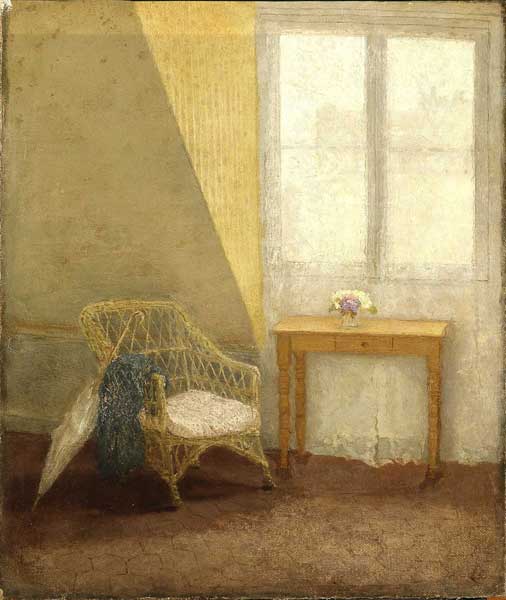Great Works: A Corner Of The Artist's Room In Paris(1907-09), Gwen John
Sheffield Galleries

A picture can make objects into a portrait or self-portrait; an empty room into a life or a personality. For instance, there is the memorial image by the famous London illustrator, Luke Fildes. It shows The Empty Chair, Gad's Hill – Ninth of June 1870, which was published in the Christmas edition of the magazine The Graphic in 1870. Fildes depicts the desk and chair in Charles Dickens's library, mourning his recent death.
And Van Gogh was influenced by Fildes's graphic work. The Empty Chair inspired Van Gogh to paint two chairs, in his Yellow House at Arles in 1888 – one for himself, the other for Gauguin.
Gauguin's chair is an elegant and extrovert affair, sharp-edged, carved in curves and curls and flourishes, a dandified chair that leans back and strikes a pose. It is seen by candlelight. Vincent's chair sits in daylight, in the corner of the kitchen. The chair is a plain and honest chair and emphasises how simply the thing is constructed.
The artist shows himself as a humble, practical type, interested in how things are made. The chair is remade as a piece of wonky home-made furniture. He reweaves its seat in fat strands of brushstrokes, makes it his own. It is a strong picture of self-image.
And as for Gwen John? The painter had her own self-image. She lived in Paris, in a room of her own, at 87 Rue de Cherche-Midi in Montparnasse. For money, she worked as an artist's model, in particular for the sculptor Rodin, with whom she had a troubled liaison. She didn't do much painting.
A Corner of the Artist's Room in Paris is a picture of her personal space. Only a foot high, it's like a diary record, a memorisation of a particular place and time and mood – this top-floor room, with the steep slope of the mansard roof cutting into it and the bright day flooding through the windows, held back and diffused by the floor-length net curtains.
It's a minimal scene – a sense of quiet and a sense of order. Its contents itemised distinctly. You can count them on one hand: chair, table, parasol, garment, vase of flowers. There's a transparent geometry in the forms of the windows, walls and floor.
It's a room high above street level – which is of course a cheap room, too. It's frugally furnished but kept tidy. Its forms are few and clear. And the way it's painted conveys a feeling of frailty, in the pale and subdued colours, the weak strands of the woven wicker chair, the thin stem of the parasol, the thin paint just barely touched and stroked onto the surface of the canvas.
The room portrays a state of mind, a life. The adjectives say it: pale, bare, thin, weak, few, quiet, clear, light-filled. It's a refuge, a retreat, an interior space, a place of safety and manageability, for someone in a very fragile condition. "Une petite morceau de souffrance et de désir," as John described herself at the time; a little piece of suffering and desire.
But if this image was as faint, frail, delicate and trembly as that sounds, if that was all it was, it wouldn't hold. It does, though. And what empowers it is that sharp descending triangle, which pierces the space, and the sharp contrast between light and shade along the line of its slanting edge. This shape is the picture's most dramatic event. It interrupts the atmosphere of eternal convalescence with a saving gesture of assertion, a grip of definition, a sign of strength. This room is a theatre, but with no figures.
ABOUT THE ARTIST
Gwen John (1876-1939) used to be the sister of the more famous Augustus. But their fame has swapped places, as he predicted it would. The flamboyant Gus now looks shallow and hearty. The recessive Gwen is a reclusive, introspective, obsessive talent in the true Modernist mould. A Slade student, she moved to France and studied with Whistler, adopting his greys and muted tones. For a time she was Rodin's model and lover. She painted the same subject repeatedly, pursuing small differences, a Morandi of the solitary female figure. Later became a Catholic, and painted nuns over and over again.
Join our commenting forum
Join thought-provoking conversations, follow other Independent readers and see their replies
Comments